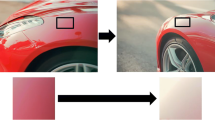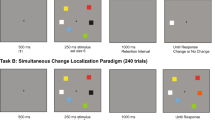Abstract
In three experiments we studied change detection and identification when no extraneous transients were present in the image at the time of change. Each image consisted of 12 different objects, sorted by color into three different levels of probability of change. In Experiment 1, change of one object was detected and identified frequently in objects having the highest probability of change (central interest), which we hypothesize were mainly visited by attention. Changes in other objects with a lower probability of change (marginal interest), however, although detected efficiently were unlikely to be identified. Identification improved for less attended objects if the changed stimulus simply disappeared, allowing visual persistence to hold information about the object until attention could be shifted to it (Experiment 2). Contrary to previous findings showing that response times (RTs) for luminance change detection in a multi-element display are not altered by attention, we found changes in objects of central interest to be detected faster than in objects of marginal interest when objects’ identity was to be held in working memory. However, no differences in RTs emerged in the same change detection task when objects’ identity was not stored in working memory (Experiment 3).




Similar content being viewed by others
References
Agostinelli G, Sherman SJ, Fazio RH, Hearst ES (1986) Detecting and identifying change: addition versus deletion. J Exp Psychol Hum Percept Perform 12:445–454
Beck MR, Levin DT (2003) The role of representation volatility in recognizing pre- and postchange objects. Percept Psychophys 65:458–468
Becker MW, Pashler H, Anstis SM (2000) The role of iconic memory in change detection tasks. Perception 29:273–286
Bonnel AM, Stein JF, Bertucci P (1992) Does attention modulate the perception of luminance change?. Q J Exp Psychol 44A:601–626
Bravo MJ, Nakayama K (1992) The role of attention in different visual search tasks. Percept Psychophys 51:465–472
Brawn P, Snowden RJ (1999) Can one pay attention to a particular color? Percept Psychophys 61:860–873
Brawn P, Snowden RJ, Wolfe JM (1999) The minimal conditions for “change blindness”: what is replace what was. In: Poster presented at the annual meeting of the Association of Research in Vision and Opthalmology Fort Lauderdale
Breitmeyer BG, Ganz L (1976) Implications of sustained and transients channels for theories of visual pattern masking, saccadic suppression, and information processing. Psychol Rev 83:1–36
Bridgeman B, Hendry D, Stark L (1975) Failure to detect displacement of the visual world during saccade eye movements. Vis Res 15:719–722
Bundesen C (1990) A theory of visual attention. Psychol Rev 97:523–547
Cave KR (1999) The FeatureGate model of visual selection. Psychol Res 62:182–194
Chelazzi L, Duncan J, Miller EK, Desimone R (1998) Responses of neurons in inferior temporal cortex during memory-guided visual search. J Neurophysiol 80:2918–2940
Coltheart M (1980) Iconic memory and visible persistence. Percept Psychophys 27:183–228
Corbetta M, Shulman GL (2002) Control of goal-directed and stimulus-driven attention in the brain. Nat Rev Neurosci 3:201–215
Desimone R (1998) Visual attention mediated by biased competition in extrastriate visual cortex. Philos Trans R Soc Lond B 353:1245–1255
Desimone R, Duncan J (1995) Neural mechanisms of selective visual attention. Annu Rev Neurosci 18:193–222
Deubel H, Bridgeman B, Schneider WX (2004) Different effects of eye blinks and target blanking on saccadic suppression of displacement. Percept Psychophys 66:772–778
Di Lollo V, Dixon P (1988) Two forms of persistence in visual information processing. J Exp Psychol Hum Percept Perform 14:671–681
Downing PE (2000) Interactions between visual WM and selective attention. Psychol Sci 11:467–473
Duncan J, Humphreys GW (1989) Visual search and stimulus similarity. Psychol Rev 96:433–458
Gegenfurtner KR, Sperling G (1993) Information transfer in iconic memory experiments. J Exp Psychol Hum Percept Perform 19:845–866
Grimes J (1996) On the failure to detect changes in scene across saccades. In: Akins K (eds) Perception: vancouver studies in cognitive sciences. Oxford University Press, Oxford UK, pp 89–110
Henderson JM, Hollingworth A (1999) The role of fixation position in detecting scene changes across saccades. Psychol Sci 10:438–443
Henderson JM, Weeks PA, Hollingworth A (1999) Eye movements during scene viewing: Effect of semantic consistency. J Exp Psychol Hum Percept Perform 25:210–228
Irwin DE (1991) Information integration across saccadic eye movements. Cogn Psychol 23:420–456
Jonides J (1981) Voluntary versus automatic control over the mind’s eye’s movement. In: Long JB, Baddeley AD (eds) Attention and performance IX. Erlbaum, Hillsdale, pp 187–203
Klein RM, Kingstone A, Pontefract A (1992) Orienting of visual attention. In: Rayner K (eds) Eye movements and visual cognition: scene perception and reading. Springer, Berlin Heidelberg New York, pp 46–65
Levin DT, Simons DJ (1997) Failure to detect changes to attended objects in motion pictures. Psychon Bull Rev 4:501–506
Luck SJ, Vogel EK (1997) The capacity of visual working memory for features and conjunctions. Nature 390:279–281
McConkie GW, Currie CB (1996) Visual stability across saccades while viewing complex pictures. J Exp Psychol Hum Percept Perform 22:563–581
Mondy S, Coltheart V (2000) Detection and identification of change in naturalistic scene. Vis Cogn 7:281–296
Oh S-H, Kim M-S (2004) The role of spatial WM in visual search efficiency. Psychon Bull Rev 11:275281
O’Regan JK (2001) Thoughts on change blindness. In: Harris LR, Jenkin M (eds) Vision and attention. Springer, Berlin Heidelberg New York, pp 281–302
O’Regan JK, Rensink RA, Clark JJ (1999) Change-blindness as a result of “mud-splashes”. Nature 398:34
O’Regan JK, Deubel H, Clark JJ, Rensink RA (2000) Picture changes during blinks: looking without seeing and seeing without looking. Vis Cogn 7:191–211
Pashler H (1988) Familiarity and visual change detection. Percept Psychophys 44:369–378
Rensink RA (2002) Change detection. Annu Rev Psychol 53:245–277
Rensink RA, O’Regan JK, Clark JJ (1997) To see or not see: the need for attention to perceive changes in scene. Psychol Sci 8:368–373
Simons DJ (1996) In sight, out of mind: when object representation fails. Psychol Sci 7:301–305
Simons DJ, Levin DT (1997) Change blindness. Trends Cogn Sci 1:261–267
Simons DJ, Wang RF (1998) Perceiving real-world viewpoint changes. Psychol Sci 9:315–320
Singer W, Phillips WA (1974) Function and interaction of on and off transients in vision. II. Neurophysiology. Exp Brain Res 19:507–521
Snowden RJ, Hess RF (1992) Temporal frequency filters in the human peripheral visual field. Vis Res 32:61–72
Theeuwes J (1991) Exogenous and endogenous control of attention: the effect of visual onset and offsets. Percept Psychophys 49:83–90
Treisman A (1982) Perceptual grouping and attention in visual search for features and objects. J Exp Psychol Hum Percept Perform 40:201–237
Tsal Y, Lavie N (1988) Attending to color and shape: the special role of location in selective visual processing. Percept Psychophys 44:15–21
Turatto M, Galfano G (2000) Color, form, and luminance capture attention in visual search. Vis Res 40:1639–1643
Turatto M, Galfano G (2001) Attentional capture by color without any relevant attentional set. Percept Psychophys 63:286–297
Turatto M, Bettella S, Umiltà, C, Bridgeman B (2003) The perceptual conditions necessary to induce change blindness. Vis Cogn 10:233–255
Vogel EK, Woodman GF, Luck SJ (2001) Storage of features, conjunctions and objects in visual working memory. J Exp Psychol Hum Percept Perform 27:92–114
Warner CB, Juola JF, Koshino H (1990) Voluntary allocation versus automatic capture of visual attention. Percept Psychophys 33:129–138
Watanabe K (2003) Differential effect of distractor timing on localizing versus identifying visual changes. Cognition 88:243–257
Wheeler ME, Treisman AM (2002) Binding in visual short term memory. J Exp Psychol Gen 131:48–64
Wolfe JM, (1994) Guided Search 2.0: a revised model of visual search. Psychon Bull Rev 1:202–238
Wolfe JM (1999) Inattentional amnesia. In: Coltheart V (eds) Fleeting memories: cognition of brief visual stimuli. MIT Press, Cambridge, pp 71–94
Woodman GF, Luck SJ (2004) Visual search is slowed when visuospatial WM is occupied. Psychon Bull Rev 11:269–274
Yantis S (2000) Goal-directed and stimulus-driven determinants of attentional control. In Monsell S, Driver J (eds) Attention and performance XVIII. MIT Press, Cambridge, pp 73–104
Acknowledgements
The authors wish to thank Anna Daccordo for her help in data collection, and three anonymous reviewers for their helpful comments on an earlier draft of this manuscript. This research was supported by grants from Ministero della Istruzione, Università e Ricerca scientifica (MIUR) and University of Trento to M. Turatto.
Author information
Authors and Affiliations
Corresponding author
Rights and permissions
About this article
Cite this article
Turatto, M., Bridgeman, B. Change perception using visual transients: object substitution and deletion. Exp Brain Res 167, 595–608 (2005). https://doi.org/10.1007/s00221-005-0056-4
Received:
Accepted:
Published:
Issue Date:
DOI: https://doi.org/10.1007/s00221-005-0056-4




